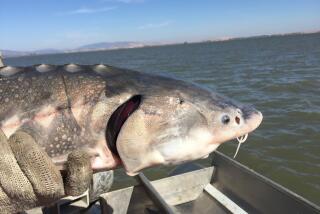U.S. to Protect Rare White Abalone
- Share via
White abalone, the most succulent and rarest of California’s abalone populations, began receiving federal protection as an endangered species Tuesday.
The abalone have been off-limits to fishing for five years. Placing them on the endangered species list imposes criminal penalties for harvesting and may make federal money available to help revive the species.
White abalone were once so plentiful that divers found 5,000 of the mollusks per acre in waters off Southern California. Now, there are fewer than 2,600 adult white abalone scattered throughout their range from Point Conception north of Santa Barbara down through much of Baja’s Pacific coast.
“Because white abalone is in danger of going extinct in the foreseeable future, we need to protect and spur recovery of the species,” said Bill Hogart, acting director of the National Marine Fisheries Service.
The fisheries service will soon appoint a recovery team of scientists to figure out how to save white abalone, which were plundered in the 1970s by commercial and sports harvesting driven by an insatiable public.
White abalone, unlike their green, pink, red and black cousins, are so tender that their meat was often cooked and eaten without the tenderizing pounding usually needed to prepare abalone steaks.
It became a delicacy in seafood houses and high-end restaurants beginning in the late 1960s. The abalone populations crashed from overfishing--despite limits imposed on the size and number that could be taken.
“We just weren’t paying attention,” said Gary Davis, an abalone expert and science advisor to Channel Island National Park. “The strategy was to take the big ones and leave the smaller ones to reproduce. But the surviving small ones were scattered so far apart, they couldn’t find each other to reproduce.”
Scientists estimate that more than 99% of the species has vanished, declining from as many as 4.24 million to somewhere between 1,613 and 2,540 animals today, according to scuba submarine surveys.
White abalone, like several abalone species, have been off-limits to fishing in California waters since 1996. But white abalone, which sold for $100 or more for each animal before the state Department Fish and Game ban took effect, still face pressure from poaching.
So the federal fisheries service brushed aside suggestions from conservation groups and others that it designate “critical habitat,” sort of a last refuge for a species struggling for survival.
“Highlighting where these guys could be found would not be prudent,” said Jim Lecky, assistant regional administrator for the fisheries service.
Or, as others put it, designating critical habitat would be like creating an underwater treasure map for unscrupulous divers.
White abalone, which usually live in depths of 70 to 200 feet, did not become popular until the late 1960s when other species that cling to rocks at shallower depths were getting harder to find.
White abalone were mostly found in coastal waters north of Santa Barbara, off the Channel Islands and farther out, in underwater pinnacles surrounding Cortez and Tanner banks, as well in coastal waters off central Baja California.
The spiral-shelled animals can live 30 years or more and grow as big as 10 inches across. Commercial fishermen in California have not reported harvesting a white abalone since 1992, coinciding with a general collapse of the abalone industry.
But harvesting remains a viable business in some parts of Mexico. The U.S. fisheries service has asked the Mexican government for information on any conservation measures it has taken. So far, it has received no response.
The protections afforded under the federal Endangered Species Act have no authority in Mexican waters. However, the act makes it illegal to import white abalone to the United States.
In California waters anyone who took a white abalone would be subject to federal fines and sanctions as well as those imposed by the state Department of Fish and Game.
In addition, the fisheries service would have to be consulted any time a federal permit or money was used in coastal development, oil and gas drilling, or building sewage outfall pipelines that could harm white abalone or their remaining habitat.
The fisheries service suggests that listing white abalone as endangered will have minimal effect on offshore oil development or other coastal activities.
More to Read
Sign up for Essential California
The most important California stories and recommendations in your inbox every morning.
You may occasionally receive promotional content from the Los Angeles Times.













